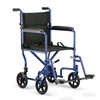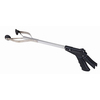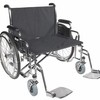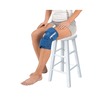Choosing the Right Manual Wheelchair
Posted on
At Island Mediquip we carry an assortment of lightweight manual wheelchairs, tilt wheelchairs, and transport wheelchairs. Deciding which one is the perfect fit for you can be challenging, considering it will be an essential part of your daily life. The right choice should align with your preferences, home setup, environment, and lifestyle. Here are key considerations to keep in mind.
Types of Wheelchairs
Firstly, wheelchairs come in two primary types: Self-Propelled and Attendant-Propelled. Self-Propelled wheelchairs are designed to allow the user to move independently, as they are equipped with larger rear wheels and push-rims that enable self-manoeuvring using upper body strength. However they also typically have handles for attendants to assist when needed.
If assistance is always needed an Attendant-Propelled wheelchair might be more suitable. These feature smaller rear wheels, enhancing maneuverability for the person pushing. This means however that the occupant is not independent as they cannot self-manoeuvre the chair.
Factors to Consider
After determining the type of wheelchair required, there are still several factors to consider in terms of using it. Of course the first thing to evaluate is what your individual needs are. What kind of features are needed? See below for typical features to keep in mind.
It’s important to not only look at your current situation but also think about how things may evolve over time. While it may be uncomfortable to think about changes in disability, be thorough in selecting a wheelchair that accommodates both current and future needs.
Overall Wheelchair Weight
The weight of a wheelchair affects its usability significantly, notably in how it works to transport and just the ease of pushing it. A lighter frame makes it easier to lift and stow in a car, plus pushing becomes more manageable and enhances maneuverability. The downside can be the potential cost, as standard chairs feature a steel frame, whereas more lightweight options are crafted from aluminum, which can be at a higher cost.
Storage
Is your wheelchair going to be used daily or will it need to be packed up and stored away often? If it frequently needs to be stored features such as detachable footplates, removable arms, and wheels will be helpful as these elements decrease the chair's weight during lifting.
Frequency of Use
The intended use is a key factor when deciding on what wheelchair is best. Some chairs are more tailored of occasional use, such as for short trips to appointments or the store, while others are better suited for frequent and continuous use. Ensure your chosen wheelchair aligns with your pattern of use, as opting for a model designed for sporadic use may not only lack durability but also comfort, as wheelchairs crafted for regular use provide an overall enhanced experienced for the occupant.
Size
It’s important to factor in the dynamics of your weight, height, and width. As a general guideline it is recommended that the seat width be 1cm to 4cm wider than your hips, as this ensures optimal comfort during use. All wheelchairs have a maximum user weight capacity, so make sure that whatever you choose is safe and supportive for your needs.
Wheelchair Features
Here are a few of the most common features to keep in mind to ensure maximum comfort:
Seats
Often available in different lengths, widths, and firmness. You need to ensure that wherever possible your weight is evenly distributed over the seat area as this will provide the most comfortable sitting position and help prevent any pressure sores from forming. Cushioning can also be added to give more postural support and relieve pressure, so test to see which is most comfortable for you.
Armrests
Make sure armrests are not positioned too high as this can lead to hunched shoulders, or if too low it can cause leaning. Note that height-adjustable armrests are typically found in more specialized wheelchair models.
Footplates
Most footrests swing away for safe transfers and easy transport. Elevating leg rests are available for extended leg elevation, while shorter, padded extensions cater to specific needs.
Tires
Wheelchair tires come in three primary types: solid, air-filled pneumatic, and flat-free, the latter being pneumatic tires filled with a semi-solid material. While solid tires offer durability, they might provide a less comfortable ride. Pneumatic tires on the other hand offer a more comfortable experience but require regular maintenance, including keeping them adequately inflated. Flat-free tires are crafted to be puncture-resistant but may be heavier and more challenging to replace.
We understand that choosing a wheelchair involves numerous factors, which can be overwhelming. Our goal is to assist you in finding the right wheelchair without unnecessary stress, so come in store or give us a call to see how we can help. Plus we offer rental options for those who aren't ready for a long-term commitment, allowing you to test for which wheelchair will suit your needs.


















